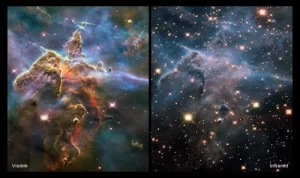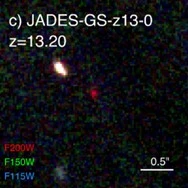A new eye in the sky
Launched on 25th December 2021, the James Webb Space Telescope is the pinnacle of Space Tech in the entire scientific community of this decade. Especially, in understanding the universe right from its origin. JWST is the successor of Hubble but with a new set of eyes.
Unlike Hubble, JWST probes deeper and farther. Hubble was built primarily around visible and ultraviolet light regions of the electromagnetic spectrum with some capabilities in the near-infrared, whereas James Webb Space Telescope operates strictly in the infrared region. Moreover, Hubble has a mirror diameter of 2.4 meters whereas JWST features a larger diameter of 6.4 meters.
Because of these differences in the specifications, the objective of JWST differs from that of Hubble. While, Hubble was meant to observe astronomical objects like planets, stars, galaxies, and nebulae, JWST focuses on studying the early universe, formation of stars & galaxies, and exoplanets.
Comparing JWST & Hubble
Here are two images, the one on the left is in Visible spectrum and the one on the right is in Infrared spectrum.
Carina Nebula in IR and Visible as taken by Hubble and JWST

This is an image of Carina Nebula, a stellar nursery where new stars are born every second. The image on the left is taken in Visible Light. Hence, we can observe the gas clouds surrounding and masking and enveloping this nebula. But when viewed through an infrared camera, the field of vision pierces through the gas clouds and you can observe stars forming right at the core of this nursery.
Such is the benefit of viewing the cosmos through Infrared. And while both Hubble and JWST differ in their objectives, it is always the layering of these data that give you a superimposed understanding of the cosmos that is more comprehensive and detailed.
But why is JWST better to study distant stars and galaxies?
Redshift is the answer. As the light from the distant stars and galaxies travel through space away from the observer, the expansion of the universe causes the light to get stretched. The light starts shifting towards a longer wavelength making it appear redder, ideal for JWST to capture and study the infrared spectrum.
What does this mean for James Webb Space Telescope ?
These capabilities for JWST means that it is ideal for studying formation of the galaxies and eventually shed more light on the formation of the universe. Naturally, we shouldn’t be completely left with scratching our heads if JWST stumbles upon something unprecedented. But like any scientific discovery, JWST, just months after it settled in its orbit at the Lagrange point, is baffling astronomers with every set of images.
To add to the list, the recent disruption JWST has caused is challenging our understanding of Big Bang, the very formation of our universe.
What does Big Bang theory define?
For uninitiated, let us understand what Big Bang theory defines!
The Big Bang is the prevailing scientific explanation for the formation of the universe. Emerging from a singularity, the universe began from a dense, hot, and incredibly small point, some 13.8 billion years ago. Right after the explosion (the bang), the universe underwent a period of inflation, where space expanded to create room for matter. The first matter that was formed seconds after the big bang were sub-atomic particles like electrons, protons, neutrinos and so on.
Shortly thereafter, the universe began to cool. A period of total darkness and silence known as the dark age of the universe. After this short hibernation, matter started to coalesce to form atoms. And atoms coalesced to form the first stars, spreading speckle of light in what was a pitch-black universe. By next 100 – 300 million years after the big bang, stars were beginning to form and fill the universe. As the population of stars increased, galaxies came into being. And within 1-2 billion years from the big bang, the first and the most primitive galaxies came into existence.
Scientists had a very strong understanding of this timeline and the process, mainly supported by 4 aspects:
1. Cosmic Microwave Background Radiation:
As early as 1965, Arno Penzias & Robert Wilson detected a faint background radiation dispersed all over the cosmos. It is the residual heat from the early stages of the universe, a form of radiation which is essentially the “afterglow” of the Big Bang, that has been stretched and cooled over time. The distribution, spectrum, and the temperature of CMB matches the predictions and is established as one of the strongest pieces of evidences supporting Big Bang. As the universe began to cool after the Inflation, protons and electrons combined to form neutral hydrogen atoms, allowing light to travel freely and release of the CMBR.
2. Hubble’s Law, Redshift, and Expanding Universe:
In the 1920s, while studying light emitted from distant galaxies, Edwin Hubble noticed that the spectra of these faraway galaxies obey a systematic shift towards longer wavelengths. He discovered that as the galaxies drift away from us, the light traveling from those galaxies gets stretched. Observations also show that the recessional velocity is proportional to their distance, meaning that galaxies farther away from us recede at a faster pace than those closer to us. Scientists interpreted this redshift as evidence that the galaxies were moving away from us, and they found that the magnitude of the redshift is proportional to their distance from Earth.
The redshift aligns with the theory of the Big Bang. And suggests that the universe originates from a hot, dense state and has been set into perpetual expansion.
3. Abundance of Light Elements in the early formed universe:
According to the theory of Big Bang, the newly-borne universe that gave birth to sub-atomic particles seconds after the explosion, facilitated nuclear fusion in a hot & dense surrounding. Our observations matched that of what Big Bang model had predicted particularly when it comes to Hydrogen and Helium. The observed ratio of these elements align closely to what Big Bang predicted, reaffirming the validity of this theory.
4. Large-scale structures of the universe:
The formation of large-scale structures in the universe, such as galaxies, galaxy clusters, and cosmic filaments, is consistent with the predictions of the Big Bang theory. Through the process of gravitational instability, small density fluctuations in the early universe grew over time, leading to the formation of these structures. Observations of the large-scale distribution of matter in the universe support this aspect of the Big Bang theory.
These factors in combination with observations were enough to convince the scientific community that Big Bang is the most plausible answer to how our universe came into being. Until JWST stumbled upon what many astronomers would consider came out of the left-field.
What did JWST uncover that threatens to challenge Big Bang?

Although, looks merely a speck or a blob, JWST recently discovered not one, two or three but FOUR remote galaxies. These galaxies date back to the dark ages. Among the four, JADES-GS-z13-0 is the oldest and the most distant one that formed a mere 320 million years after the Big Bang. This not only upsets the timeline predicted by Big Bang but also questions our understanding of the universe. JWST confirmed large and fully-formed galaxy that dates back to the dark ages of the universe. And astronomers are finding it difficult to understand why!
Can AI take over deep space exploration? Has it already done so?
During its initial observation, the James Webb Space Telescope discovered a strange galaxy pair. A colossal galaxy that dwarfs even our Milky Way galaxy. And its companion, a pint-sized galaxy that should not even exist. All in the early universe.
Naturally, these discoveries have created an uproar among the astronomers. So much so, scientists are going back to the drawing board. They are scrambling to explain the existence of these galaxies. These discoveries might mean that we have to rewrite our text-books and alter some of our understanding. Because as per our standard model of cosmology, this behemoth galaxy shouldn’t even exist in the given time period. This giant galactic behemoth formed just 500 million years after the Big Bang. This is 10x more massive than our Milky Way Galaxy.
But why does a presence of a gigantic galaxy in the early universe create such huge shockwaves?
As per our current understanding, the biggest galaxies in the universe are thought to have taken billions of years to form. But the recent discovery by James Webb Space Telescope suggests that galaxies are forming at a breakneck rate.
Such observations are now raising the possibility like: Is Universe expanding faster than predicted? And if it is expanding at a faster rate, then it requires explanation of new forces. Or even type of energy that can validate this exaggerated expansion. Furthermore, these galaxies seem to be converting nearly 100% of their gases into stars, which is only possible in theory.
Simultaneously, the mini galaxy discovered alongside this giant galaxy dates back to 500 million years. Right after the Big Bang which is churning out stars at an unprecedented rate. The real kicker is this galaxy is only 16 parsecs wide, the smallest ever recorded. The findings and our current understanding fail to explain these anomalies.
Roger Penrose’s Prediction
Roger Penrose, the Nobel Prize Winner, opines that the acceleration of our universe may be the reason for Black Holes. Even stranger, a black hole from a previous universe. All pointing to an existence of cyclic universe.
Conclusion
JWST has been in space for some mere months. But the discoveries it is making everyday challenges our centuries of understanding dating back to 13 billion years. As the research continues, JWST, no wonder, will keep baffling the astronomers, everyday! And may be help us reveal some of the enigmas this limitless cosmos holds for us.



